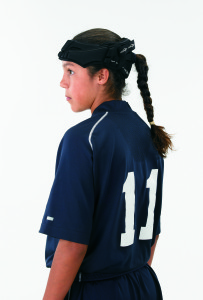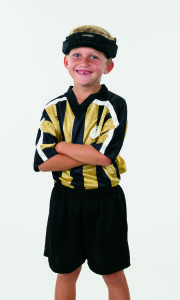Soccer Headgear Minimizes Concussions
 In a more recent study on concussions, JAMA Pediatrics found that out of the following sports for girls, basketball, softball, soccer and volleyball and for boys, baseball, soccer, football, basketball, and wrestling, the rate of concussions was second highest in girls soccer and fifth highest in boys soccer. We know that concussions are frequent, yet the alarming thing is that it has been difficult for soccer leagues and organizations to adopt practices and rules to help reduce head injury. We need to look at options and solutions that can help protect soccer players at all levels of competition. There are three aspects we can explore: education, prevention, and reaction which is closely tied to education.
In a more recent study on concussions, JAMA Pediatrics found that out of the following sports for girls, basketball, softball, soccer and volleyball and for boys, baseball, soccer, football, basketball, and wrestling, the rate of concussions was second highest in girls soccer and fifth highest in boys soccer. We know that concussions are frequent, yet the alarming thing is that it has been difficult for soccer leagues and organizations to adopt practices and rules to help reduce head injury. We need to look at options and solutions that can help protect soccer players at all levels of competition. There are three aspects we can explore: education, prevention, and reaction which is closely tied to education.
Education
It is important to teach players from the youth level to high school, college or even professionally the dangers of concussions and head injuries. It is just as important to educate parents and coaches. The long-term effects of concussions can arise after a long period from the time of injury. Long-term effects of concussions include memory issues, personality changes, inability to concentrate or problem solve, aggression and more. In another study on concussion patients by the U.S. National Institutes of Health, researchers found that the brain in these patients still showed injury and trauma months after the initial injury. While immediate concussion symptoms began to dissipate, brain scans displayed abnormalities in the brain. By understanding the lasting damage of one or many concussions, players, parents and coaches may further understand and realize the importance of prevention and risks that come with playing soccer.
Prevention
 Following education, comes prevention. We know the type of damage concussions can cause, what can we do about them? Players who wear protective soccer headgear suffer nearly half as many concussions as those who play without helmets, according to a study conducted by researchers at Canada's McGill University.
Following education, comes prevention. We know the type of damage concussions can cause, what can we do about them? Players who wear protective soccer headgear suffer nearly half as many concussions as those who play without helmets, according to a study conducted by researchers at Canada's McGill University.
Researchers followed 250 adolescent (ages 12 to 17) soccer players during the 2006 season. They found that 53 percent of those who did not wear protective headgear suffered concussions compared to 27 percent of those who wore soccer safety gear. The study, published in the July 2007 issue of the British Journal of Sports Medicine, also found that:
- Nearly half of the players (47.8%) experienced symptoms of a concussion during the 2006 season.
- Approximately 4 out of 5 athletes did not realize that they had suffered a concussion
- Multiple concussions were less frequent among the injured athletes (50.0%) who wore protective headgear than those who did not (69.3%).
- Nearly one-quarter (23.9%) of players suffering concussions experienced symptoms for at least one day or longer.
- Female soccer players were at increased risk of suffering concussions.
- Female soccer players not wearing soccer headbands were also at increased risk of suffering other kinds of head injuries, such as abrasions, lacerations or contusions on areas of the head that otherwise would have been covered by the headgear.
 Some organizations like U.S. Soccer have begun to take preventative measures to help improve player safety by banning headers for children under age 10. This is very important and key step taken that many organizations should consider. However, headers are part of the game one might argue. What else can you do? You can take the step to lessen the impact caused by headers on the ball or with another player with soccer headgear like the DonJoy Hat Trick. This soccer concussion helmet absorbs the impact through the padded foam layer which wraps around the head to protect the key impact areas of the head, forehead, back of the head and the temples. In any league, competition or play that allows headgear, you should consider ways to prevent traumatic brain injury. The DonJoy Hat Trick meets the performance requirement in ASTM F2439 and is allowed by FIFA, the U.S. Soccer Federation and NFHS.
Some organizations like U.S. Soccer have begun to take preventative measures to help improve player safety by banning headers for children under age 10. This is very important and key step taken that many organizations should consider. However, headers are part of the game one might argue. What else can you do? You can take the step to lessen the impact caused by headers on the ball or with another player with soccer headgear like the DonJoy Hat Trick. This soccer concussion helmet absorbs the impact through the padded foam layer which wraps around the head to protect the key impact areas of the head, forehead, back of the head and the temples. In any league, competition or play that allows headgear, you should consider ways to prevent traumatic brain injury. The DonJoy Hat Trick meets the performance requirement in ASTM F2439 and is allowed by FIFA, the U.S. Soccer Federation and NFHS.
Reaction
Being reactive means to know when you or a player has suffered a concussion and knowing how to respond properly. Symptoms include memory loss, blurred vision, blackout, dizziness, head pain, nausea, and disorientation. You may experience difficulty speaking or walking. If you or your child has suffered impact to the head, it is crucial to look for symptoms of concussion and immediately pull out of the game. Often times, athletes do not take concussions or trauma to the head seriously. They may think they feel fine or want to continue playing. They don't understand the dangers in continuing to play or consider what another blow to the head might mean. Repeat concussions can cause serious brain damage. It is important as parents, players, or coaches to consider the life risk of not stopping play. If signs of a concussion are present, stop play and seek medical attention immediately.
By learning about head injuries, being proactive about soccer head gear, and reacting appropriately, we can take steps in reducing head trauma on the soccer field. Take care of your players and take care of your brain. Do not become another soccer injury statistic.
Additional Resources
http://www.webmd.com/brain/news/20131120/concussions-damage-to-brain-lingers-after-symptoms-fade-study





1 Comment